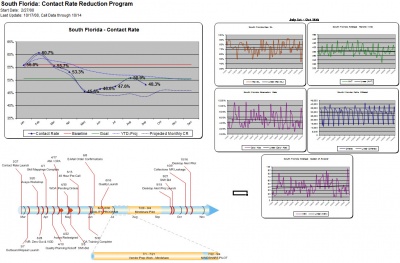Difference between revisions of "Cost Improvement Programs"
(Created page with "Category:Forecasting == Cost Improvement Programs== Workforce Management: Cost Improvement Programs Forecasting: ''The fu...") |
|||
| Line 2: | Line 2: | ||
== Cost Improvement Programs== | == Cost Improvement Programs== | ||
[[file:cost-improvement.jpg|thumb|400px|border|Workforce Management: Cost Improvement Programs]] | [[file:cost-improvement.jpg|thumb|400px|border|Workforce Management: Cost Improvement Programs]] | ||
| − | + | Workforce Management organizations often are leveraged for establishing baseline metrics within a contact center and validating whether identified cost or metric improvement initiatives have yielded improvements in contact center operations. While 1:1 correlations are not always feasible, changes that are implemented and properly base-lined can be examined by a WFM organization to evaluate whether volumes, handle-time, shrinkage, or occupancy have changed as the result of that activity. | |
| − | + | Below is a sample real-life contact rate reduction plan. In this plan, WFM would support validations of various segments. | |
| − | == | + | == Executive Summary == |
| − | + | == Methodology == | |
| − | + | ==No Single Cause== | |
| − | + | ||
| − | + | Avaya Call Routing & Skills | |
| − | + | ||
| − | + | SL% Challenge, Forecasting and Staffing Models | |
| − | + | ||
| − | + | Quality Control | |
| − | + | ||
| + | IVR Audit | ||
| + | |||
| + | Escalation Process | ||
| + | |||
| + | Field Quality | ||
| + | |||
| + | Business Process Audit | ||
| + | |||
| + | Communications | ||
Revision as of 11:51, 16 July 2016
Cost Improvement Programs
Workforce Management organizations often are leveraged for establishing baseline metrics within a contact center and validating whether identified cost or metric improvement initiatives have yielded improvements in contact center operations. While 1:1 correlations are not always feasible, changes that are implemented and properly base-lined can be examined by a WFM organization to evaluate whether volumes, handle-time, shrinkage, or occupancy have changed as the result of that activity.
Below is a sample real-life contact rate reduction plan. In this plan, WFM would support validations of various segments.
Executive Summary
Methodology
No Single Cause
Avaya Call Routing & Skills
SL% Challenge, Forecasting and Staffing Models
Quality Control
IVR Audit
Escalation Process
Field Quality
Business Process Audit
Communications
